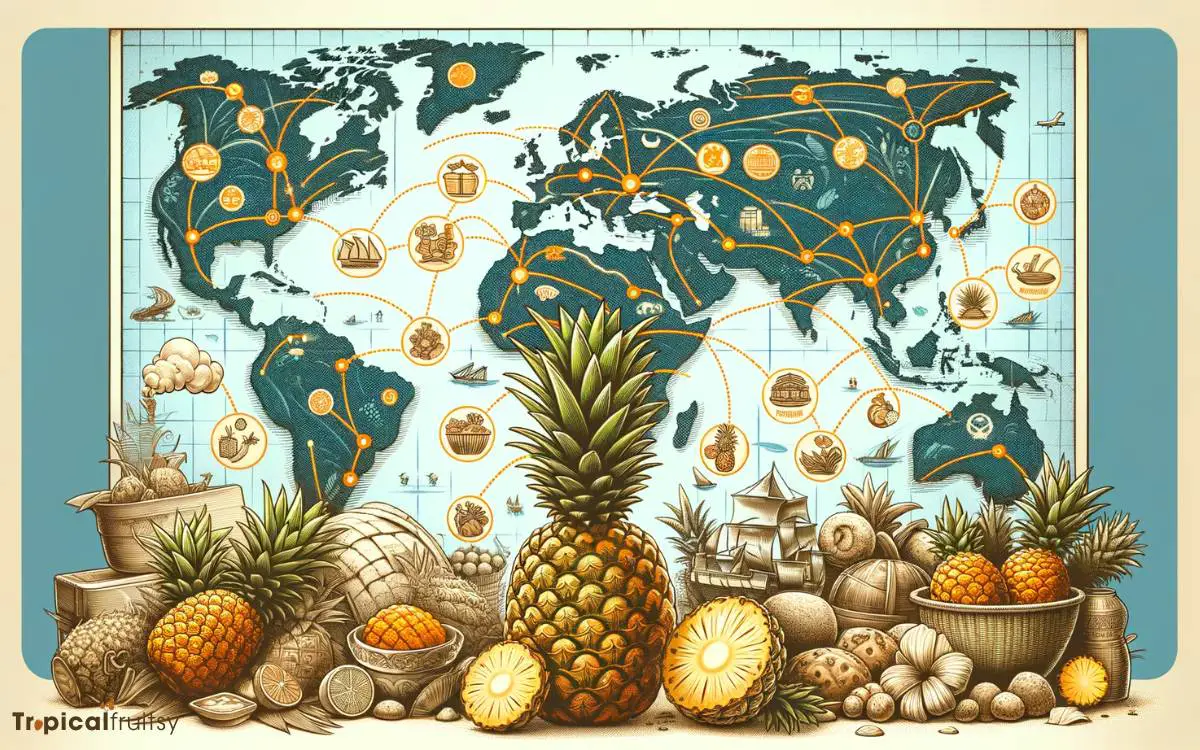Is Pineapple a Tropical Fruit? Yes!
Yes, pineapple (Ananas comosus) is indeed a tropical fruit. It thrives in warm and humid climates typical of the tropics.
Pineapples originated in South America’s tropical areas and are well-suited to conditions found there: consistent warm temperatures and a good amount of rainfall. The growth of pineapples has extended globally to regions with similar tropical climates.
Pineapple, with its unique taste and nutritious profile, is a tropical delight embraced in culinary arts worldwide.

Key Takeaway
Pineapple Origins Unveiled

The pineapple, Ananas comosus, is a tropical fruit that originated in South America. Specifically, it was first cultivated in the region that now comprises parts of Brazil and Paraguay.
This perennial plant belongs to the family Bromeliaceae. It is characterized by its tough, waxy rind, which is compound of numerous individual berries fused to the central stalk.
The pineapple’s development occurs through a process of parthenocarpy. This means that the fruit forms without fertilization and subsequent seed development.
Historically, indigenous cultures cultivated pineapples for their sweet, succulent flesh. They incorporated them into their dietary and medicinal practices.
European explorers, such as Christopher Columbus, encountered the pineapple in the late 15th century.
This led to its introduction to Europe and eventual global cultivation in tropical and subtropical regions.
The Tropical Climate Connection

Cultivating pineapples outside their native habitat necessitates a tropical climate, characterized by warm temperatures and abundant rainfall, to replicate the conditions essential for their growth.
A tropical climate offers a consistent temperature range of 18°C to 30°C, which is vital for the pineapple’s development. This narrow thermal band ensures the enzymatic processes within the plant cells operate optimally.
Additionally, high humidity levels, typically between 70% to 80%, are crucial to prevent the fruit from drying out and to maintain the turgor pressure within the plant tissues.
Annual precipitation of 1000mm to 1500mm, preferably spread evenly throughout the year, provides the necessary hydration without causing root rot due to excessive saturation.
Such climatic parameters are indispensable for successful pineapple cultivation, enabling the plant to yield juicy, flavorful fruits.
Understanding Pineapple Cultivation

Pineapple cultivation is a specialized agricultural practice that necessitates a thorough understanding of the plant’s climatic requirements and the application of appropriate harvesting techniques.
The growth of pineapples requires warm temperatures ranging from 65°F to 95°F, high humidity, and well-drained soil to prevent root rot and ensure optimal fruit development.
Precision in harvesting is paramount, as the timing and method impact fruit quality, with techniques varying based on the scale of production and intended market.
Growth Climate Requirements
Typically, pineapple thrives in a warm, humid climate with consistent temperatures ranging between 65 and 95 degrees Fahrenheit (18-35 degrees Celsius).
This temperature range is conducive to the enzymatic activities essential for pineapple growth and sugar accumulation within the fruit.
High temperatures above this range can inhibit flowering and fruit development, while low temperatures may cause the plant to become dormant and even sustain cold damage.
Pineapples require well-drained, sandy loam soils with a pH of 4.5-6.5, which are typically found in tropical regions. Adequate rainfall or irrigation is necessary to maintain soil moisture, but excessive water can lead to root rot.
With these conditions met, the pineapple plant can flourish, leading to the next critical stage of development: the harvesting techniques.
Harvesting Techniques
Upon reaching maturity, pineapples are harvested through a careful process that ensures both the quality of the fruit and the health of the parent plant for future crop cycles.
This involves the identification of an optimal maturity stage, characterized by a change in the fruit’s color and a sweet aroma.
Skilled laborers then engage in manual harvesting, delicately twisting and snapping the fruit from the stalk to minimize damage.
The crown of the pineapple, often preserved for propagation, is removed with precision to avoid harming the vegetative buds below, which have the potential to yield additional fruiting shoots.
Post-harvest handling includes trimming of the excess plant material and implementing a rigorous inspection protocol to ensure that only the highest quality pineapples reach the market.
Pineapple’s Global Journey

The pineapple, originating from South America, has undergone a significant geographical expansion since its discovery by Europeans in the 15th century.
Key cultivation export hubs have emerged in countries with ideal tropical climates, such as Thailand, the Philippines, and Costa Rica, facilitating the fruit’s availability on a global scale.
This widespread cultivation and exportation have cemented the pineapple’s status as a popular fruit across multiple continents, integrating into diverse culinary traditions and agricultural economies.
Origin and Spread
Pineapple, originating from South America, has undergone a significant global dispersion since its discovery by Europeans in the 15th century.
The fruit’s journey from its native land reflects a narrative of colonial trade, adaptation to new environments, and eventually, worldwide cultivation.
Pineapples became a symbol of hospitality and exoticism, coveted in Europe, and were soon being grown in tropical and subtropical regions across the globe.
| Era | Location | Impact |
|---|---|---|
| 15th Century | South America | Indigenous cultivation |
| 17th Century | Europe | Symbol of wealth and status |
| 19th Century | Asia & Africa | Expanded cultivation |
| 21st Century | Global | Mass production and consumption |
The table above encapsulates pineapple’s odyssey, a fruit that has woven itself into the fabric of many cultures, evoking sentiments of wanderlust and the richness of tropical abundance.
Cultivation Export Hubs
Major cultivation export hubs for pineapple include countries like Costa Rica, the Philippines, and Thailand, which lead the market in global pineapple trade.
These nations have optimized their agricultural practices to ensure high yields and quality produce that meets the demands of international markets.
Costa Rica:
- Production: Pioneering eco-friendly practices and large-scale production.
- Export: Dominates with over 50% share in the global pineapple export market.
- Philippines:
- Varieties: Known for the ‘Queen’ and ‘Smooth Cayenne’ pineapples.
- Supply Chain: Robust infrastructure for both domestic distribution and international export.
- Thailand:
- Innovation: Implements advanced agricultural technologies and post-harvest techniques.
- Market Reach: Expands through strategic partnerships and trade agreements.
These hubs facilitate pineapple’s journey across the globe, contributing to its popularity across continents.
Popularity Across Continents
Bridging the gap between diverse cultures, pineapple has become a ubiquitous symbol of hospitality and exotic flavor on a global scale.
This succulent fruit has traversed the world’s continents, adapting to various climates and agricultural practices, yet maintaining its status as a sought-after commodity.
The following table illustrates key aspects of pineapple’s global journey:
| Continent | Cultivation Adaptability | Cultural Significance |
|---|---|---|
| Asia | High yield in tropical climates | Integral to cuisine and festivities |
| Europe | Greenhouse cultivation in non-tropical areas | Luxury symbol, used in food and drinks |
| Americas | Native habitat, diverse cultivation methods | Staple in diets, symbol of welcome |
The table underscores pineapple’s versatility and adaptation across different regions, which has catapulted its popularity, making it a staple in diets and a centerpiece in cultural practices worldwide.
Nutritional Profile and Benefits

Within the succulent flesh of the pineapple, a treasure trove of vitamins, minerals, and antioxidants can be found, contributing to its numerous health benefits.
This nutrient-dense fruit offers a unique composition that is both beneficial for maintaining overall health and aiding in specific bodily functions.
Vitamins and Minerals
- Vitamin C: Essential for immune function and skin health.
- Manganese: Crucial for bone structure and metabolism.
Health Properties
- Bromelain: A complex mixture of substances that can act as an enzyme, aiding digestion and reducing inflammation.
- Dietary Fiber: Supports digestive health and may help in regulating blood sugar levels.
Each component of pineapple’s nutritional makeup plays a pivotal role in fortifying the body against a myriad of health challenges.
Are Pineapples Included in the Tropical Fruit Box from Tropical Fruit Box Legit?
Yes, pineapples are included in the Tropical Fruit Box from Tropical Fruit Box Legit. The Tropical Fruit Box Legitimacy Explained ensures that only high-quality, fresh tropical fruits are included in their boxes. Each box is carefully curated to provide customers with a delightful selection of tropical fruits.
Cultural Significance Worldwide

Pineapple’s ubiquity in global cuisines reflects its cultural significance, transcending mere culinary applications to symbolize hospitality and exoticism in various societies.
In the Caribbean, the pineapple is not only a staple in the diet but also a motif that appears in art and architecture, embodying the lushness of the tropics.
Moving to the American South, particularly in colonial times, the fruit was a coveted item, often displayed during social events to showcase wealth and generosity.
In Hawaii, the pineapple industry historically shaped the islands’ economy and cultural mosaic.
Internationally, the pineapple motif is utilized in textile patterns and home decor, its spiky crown and sweet interior representing an inviting warmth.
This fruit’s image and flavor have thus woven themselves into the fabric of a myriad of cultures.
Conclusion
The pineapple stands as a botanical voyager, its spiky crown and succulent flesh an allegory for discovery and global integration.
From its origins in South America to its widespread cultivation in diverse tropical climates, this fruit has traversed oceans, enriching diets and cultures with its nutritional bounty.
Emblematic of exotic landscapes and human ingenuity, the pineapple’s odyssey reflects humanity’s ceaseless quest for agricultural mastery and gastronomic delight.






